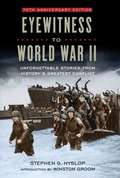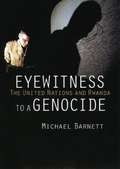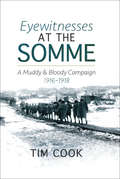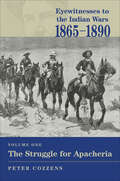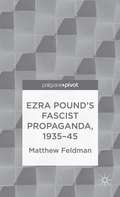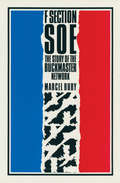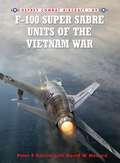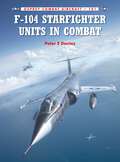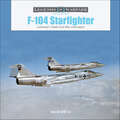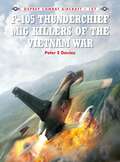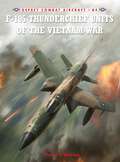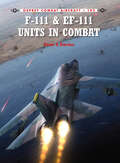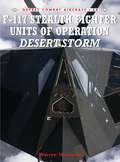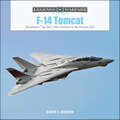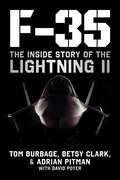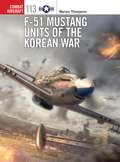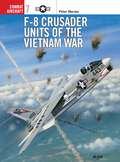- Table View
- List View
Eyewitness to World War II: Guadalcanal Diary, Invasion Diary, and John F. Kennedy and PT-109
by Richard TregaskisThree classic accounts of WWII from a reporter who &“shaped America&’s understanding of the war, and influenced every account that came after&” (Mark Bowden). Volunteer combat correspondent Richard Tregaskis risked life and limb to give American readers a soldier&’s–eye view of the Second World War. These three tales of bravery and sacrifice shed light on the Greatest Generation&’s darkest hours. Guadalcanal Diary: In August 1942, Tregaskis landed with the US Marines on Tulagi and Guadalcanal Islands in the South Pacific for the first major Allied offensive against Japanese forces. He details the first two months of the campaign and describes the courage and camaraderie of young marines who prepared for battle knowing that one in four of them wouldn&’t make it home. An instant #1 New York Times bestseller and the basis for a popular film of the same name, Guadalcanal Diary is a masterpiece of war journalism that &“captures the spirit of men in battle&” (John Toland). Invasion Diary: In July 1943, Tregaskis joined the Allied forces in Sicily and Italy and documented some of the fiercest fighting of the war, from bombing runs over Rome to the defense of the Salerno beachhead against heavy artillery fire to the fall of Naples. In compelling and evocative prose, Tregaskis depicts the terror and excitement of life on the front lines and his own harrowing brush with death when a chunk of German shrapnel pierced his helmet and shattered his skull. Invasion Diary is &“required reading for all who want to know how armies fight&” (Library Journal). John F. Kennedy and PT-109: In the early morning hours of August 2, 1943, the Japanese destroyer Amagiri sliced into US Navy motor torpedo boat PT-109 near the Solomon Islands. Ten surviving crewmembers and their young skipper, Lt. John F. Kennedy, clung to the wreckage. Over the next three days, the privileged son of a Boston multimillionaire displayed extraordinary courage and leadership as he risked his life to shepherd his crew to safety and coordinate a daring rescue mission deep in enemy territory. Lieutenant Kennedy earned a Navy and Marine Corps Medal and a Purple Heart, and the story of PT-109 captured the public&’s imagination and helped propel Kennedy all the way to the White House. Acclaimed war correspondent Tregaskis—who once beat out the future president for a spot on the Harvard University swim team—brings this remarkable chapter in American history to vivid life.
Eyewitness to World War II: Unforgettable Stories From History's Greatest Conflict
by Winston Groom Stephen G. HyslopThis elegant narrative edition of Neil Kagan's best-selling Eyewitness to World War II offers incredible first-person stories and amazing moments of heroism, providing new context and perspective on history's greatest conflict. The unforgettable story of World War II is told through the words of those who lived it--both on the battlefield and the home front--creating a dramatic tapestry of the wartime experience. Personal writings and recollections of Roosevelt, Hitler, and Patton, as well as letters composed by soldiers at battle and diaries of women serving in the military at home, present an absorbing narrative that tells the entire history of the war from several perspectives. In this absorbing reader's edition, a carefully curated selection of memorable, significant photographs and illuminating maps from the 2012 book accompanies the revised text. Comprehensive and compelling, this finely wrought book is as gift-worthy as its predecessor.
Eyewitness to a Genocide: The United Nations and Rwanda
by Michael BarnettVery little about the Rwandan genocide is comprehensible. A Hutu elite came to believe that Hutu salvation necessitated Tutsi extermination. The Hutus enacted their conspiracy with startling efficiency. In one hundred days, between April 6 and July 19, 1994, they murdered roughly eight hundred thousand individuals. For the statistically inclined, that works out to 333&1/3 deaths per hour, 5&1/2 deaths per minute. The rate of murder was even greater during the first four weeks, when most of the deaths occurred. The Rwandan genocide, therefore, has the macabre distinction of exceeding the rate of killing attained during the Holocaust.
Eyewitness to the Peninsular War and the Battle of Waterloo: The Letters and Journals of Lieutenant Colonel James Stanhope 1803 to 1825 Recording His Service with Sir John Moore, Sir Thomas Graham and the Duke of Wellington
by Gareth GloverThe journals of the Honourable James Stanhope are among the most remarkable eyewitness accounts of the Peninsular War and the Battle of Waterloo, and yet they have never been published before. The long fight against the French in Portugal and Spain, the campaign in Holland, then the Battle of Waterloo James Stanhope lived through all these extraordinary events and recorded them in vivid detail.Stanhope served as an aide de camp to the major commanders of the day Wellington, General Graham, Lord Paget, the Duke of York among them. And he described his experiences and observations in a lucid and candid prose that makes his journals of great historical value and of compelling interest to us today. His writing gives a graphic inside view of the military and political situation of the time as it was perceived at the top levels of the British army, and he depicts the daily experience of campaigning during the Napoleonic Wars in an unforgettable way.
Eyewitness, Being Personal Reminiscences Of Certain Phases Of The Great War,: Including The Genesis Of The Tank [Illustrated Edition]
by Major-General Ernest D. SwintonIncludes the First World War Illustrations Pack - 73 battle plans and diagrams and 198 photosMajor-General Ernest Swinton had already had a long and illustrious career in the British Army before the advent of the First World War in 1914. Appointed as the official war correspondent by the war Minister Lord Kitchener in 1914, his reporting home was the only way for the British people to follow the war as journalists were at that time banned at the front. In these dispatches from the front Swinton told the public of the bloody fighting in Flanders and the heroic efforts of the Allies to stop the German Juggernaut. The miserable conditions and bloody siege warfare of the trenches left a lasting impression on him and he looked to a scientific solution to the muddy stalemate of the Western Front. He would gain lasting fame as the architect of the "tank" project that was to revolutionize warfare in the First World War and for many years thereafter. In this volume of reminiscences he traces his involvement in the early years of the war and his later years as the driving force in the development and adoption of the tank.
Eyewitnesses at the Somme: A Muddy and Bloody Campaign, 1916–1918
by Tim CookIn 1915, news of the Australian and New Zealand Army Corps landing and the slaughter at Gallipoli stirred tens of thousands of young men to go to war.They answered the call and formed battalions of the Australian Imperial Force. By the time the new recruits were combat ready, the campaign at Gallipoli had ended. Their battlefields became the muddy paddocks of France and Belgium.Based on eyewitness account, Eyewitnesses at the Somme traces the story of one of these battalions, the 55th, from its birth in the dusty camps of Egypt through three years of brutal, bloody conflict on the bitter western front.When the Great War ended in 1918, over 500 of the 3,000 men who served in the 55th had been slain and another 1,000 wounded. Eyewitnesses at the Somme, shares personal stories of Australian men as they stared down the horrors of war with determination, courage and comradeship. With chapters devoted to the significant battles at Fromelles, Doignies, Polygon Wood, Pronne and Bellicourt, this book tells the story of one battalion, but in doing so it encapsulates the experiences of many Australians on the Western Front.
Eyewitnesses to the Indian Wars, 1865–1890: The Struggle for Apacheria
by Peter CozzensThis volume explores the history of the Apache Wars of the late 19th century Southwest through diaries, army reports, and other primary sources. Stretching from the Colorado River to the mountains east of the Rio Grande, and from northern Arizona into Sonora, Mexico, is the sprawling region once known as Apacheria. By the time the first Americans ventured into the region, the indigenous peoples known as the Apache had already been clashing with Spanish and Mexican interlopers for some time. Eyewitnesses to the Indian Wars, 1865–1890: The Struggle for Apacheria presents a selection of outstanding original accounts pertaining to the epic struggle between American and the Apache for those coveted lands. It is the first in a five-volume series telling the saga of the military struggle for the American West in the words of the soldiers, noncombatants, and Native Americans who shaped it
Ezra Pound’s Fascist Propaganda, 1935–45
by Matthew FeldmanEzra Pound was an influential propagandist for British, Italian and ultimately German fascist movements. Using long-neglected manuscripts and cutting-edge approaches to fascism as a 'political religion', Feldman argues that Pound's case offers a revealing case study of a modernist author turned propagator of the 'fascist faith'.
F Section SOE: The Story of the Buckmaster Network
by Marcel RubyThe F-Section of the SOE was a department that stood for French Section, whose job it was to carry out Churchill's famous command to 'set Europe alight'. This is the story of F-Section.
F-100 Super Sabre Units of the Vietnam War
by Peter Davies Rolando Ugolini David MenardOsprey's examination of the F-100 Super Sabre Units' participation in the Vietnam War (1955-1975). While the F-105 Thunderchief and F-4 Phantom flew the majority of the fighter-bomber missions over North Vietnam, the Thunderchief's service predecessor, the F-100 Super Sabre stayed on to fight the air war in South Vietnam until June 1971. Although it was designed as an air defence fighter, and was later given nuclear capability as the mainstay of Tactical Air Command's deterrent posture, it was the F-100's toughness, adaptability and reliability that made it ideally suited to the incessant 'taxi-rank' close support and counter-insurgency missions in Vietnam. The jet's four 20 mm cannon and external loads of bombs, rockets and fire-bombs defeated many enemy incursions, with US troops in contact expressing a preference for the accuracy and skill of F-100 pilots to save them in situations where ordnance had to be dropped very close to their own lines. Many courageous deeds were performed, although 242 F-100s and 87aircrew were lost in action. Used at the start of Operation Rolling Thunder in March 1965 as an escort for F-105 strikes, the Super Sabre fought MiGs and one pilot made a credible claim for a MiG-17 destroyed, but the more capable F-4 Phantom II soon replaced it in this role. The air-to-ground war was fought by F-100C/D/F pilots from 21 TAC and Air National Guard squadrons at six bases in South Vietnam and Thailand. From September 1965, a number of two-seat F-100Fs were equipped to detect and pinpoint SA-2 missile sites, and they led F-105s in to destroy them in hazardous missions that founded the suppression of enemy air defences (SEAD) techniques developed for F-105F and F-4C 'Wild Weasel' aircraft later in the war. Other F-100Fs replaced fragile piston-engined forward air control (FAC) aircraft, providing more survivable high-speed airborne management of strike missions. Maj George Day, awarded the Medal of Honor in 1973, was the first leader of this 'Misty FAC' unit. The aircraft's strengths and eccentricities will be examined through analysis of its performance and the anecdotes of those who flew and serviced it.
F-104 Starfighter Units in Combat
by Peter Davies Rolando UgoliniThe 'missile with a man in it' was known for its blistering speed and deadliness in air combat. The F-104C flew more than 14,000 combat hours in Vietnam as a bomber escort, a Wild Weasel escort and a close air support aircraft. Though many were sceptical of its ability to carry weapons, the Starfighter gave a fine account of itself in the close air support role. It was also well known that the enemy were especially reluctant to risk their valuable and scarce MiGs when the F-104 was escorting bombers over North Vietnam or flying combat air patrols nearby. The missions were not without risk, and 14 Starfighters were lost during the war over a two-year period. This was not insignificant considering that the USAF only had one wing of these valuable aircraft at the time, and wartime attrition and training accidents also took quite a bite from the inventory.While the F-105 Thunderchief and F-4 Phantom got most of the glory and publicity during the war in Vietnam, the Lockheed F-104 Starfighter was not given much chance of surviving in a 'shooting war'. In the event, it did that and much more. Although built in small numbers for the USAF, the F-104C fought and survived for almost three years in Vietnam. Like its predecessor the F-100, the Starfighter was a mainstay of Tactical Air Command and Air Defence Command, with whom it served with distinction as an air superiority fighter and point defence interceptor. This small, tough and very fast fighter, dubbed 'The Missile with a Man in It', was called upon to do things it was not specifically designed for, and did them admirably. Among these were close air support and armed reconnaissance using bombs, rockets and other armaments hung from its tiny wings, as well as its 20 mm Vulcan cannon, firing 6000 rounds per minute. The jet participated in some of the most famous battles of the war, including the legendary Operation Bolo, in which seven North Vietnamese MiGs went down in flames with no US losses. Even as it was fighting in Vietnam, the Starfighter was being adopted by no fewer than six NATO air forces as well as Japan and Nationalist China. It was later procured by Jordan, Turkey and Pakistan. The latter nation took the Starfighter to war with India twice in the 1960s, and it also saw combat with Taiwan. The story of the Starfighter in Vietnam is one of tragedy and of ultimate vindication. For decades the F-104's contribution to the air war in Vietnam was downplayed and its role as a ground attack machine minimised. Only in recent years has that assessment been re-evaluated, and the facts prove the Starfighter to have been able to do its job as well or better than some of the other tactical aircraft sent to the theatre for just that purpose.
F-104 Starfighter: Lockheed's Sleek Cold War Interceptor
by David DoyleThe F-104 served with fifteen major international Air Forces
F-105 Thunderchief MiG Killers of the Vietnam War
by Jim Laurier Peter DaviesUSAF Rolling Thunder strike missions tactically assaulted North Vietnamese defenses, overcoming MiG fighter jets and SAM (surface to air) missiles to devastate North Vietnam's industrial base strategically. Despite its "F-for-fighter" designation, the F-105 was designed and purchased to give the USAF an aircraft for delivery of nuclear weapons at very high speed, long range and below-the-radar altitudes. When the Vietnam War began, it was the USAF's best available tactical bomber for a "limited conventional" war as well. From 1964 to 1968 it flew the majority of bombing missions against North Vietnam, performing an effectively "strategic" role in assaulting North Vietnam's industrial and military heartland. Thunderchief crews faced North Vietnamese MiG-17s and MiG-21s more often than any other US flyers. Large formations of F-105s came under frequent attack by MiG pilots, and the F-4 Phantom II escorts that were meant to protect them were not always in the right position to fend off the attackers. F-105 crews would then defend themselves using their internal 20 mm cannon and occasionally AIM-9B Sidewinder missiles. Although their fighters were far larger, heavier and much less manoeuvrable than the adversarial MiGs, the F-105 pilots used speed and skill to down 27.5 MiG-17s - a tally in excess of that scored by USAF F-4 Phantom II crews in the same period between June 1966 and December 1967! In most cases the F-105 pilots concerned also succeeded in dropping their ordnance on targets during the same sorties.
F-105 Thunderchief Units of the Vietnam War
by Jim Laurier Peter DaviesThe F-105 was a supersonic fighter-bomber used by the USAF to great extent during the Vietnam War (1955-1975). Despite pilots' initial apprehensions about the aircraft and a variety of problems with early designs, these planes ultimately became the primary strike bomber over North Vietnam in the early stages of the Vietnam War. This book explores the crucial importance of the Thunderchief, deemed the "Thud" by many of its crews, in the Rolling Thunder campaign; it explains the pioneering suppression of enemy air defences (SEAD) methods developed by the F-105 'Wild Weasel' crews. Using first-hand narratives wherever possible, the text captures the essence of flying the "Thud" against heavy AAA, SAM and MiG defences in conditions where constricting Rules of Engagement made the pilots' task virtually impossible at times. The book also documents the other demanding missions flown over Laos and South Vietnam. The author also gives an extensive overview of the aircraft's strengths and difficulties, the development of wartime tactics and the heroic accomplishments of a selection of its aircrew.
F-105 Wild Weasel vs SA-2 'Guideline' SAM
by Jim Laurier Peter DaviesAlthough America entered the Vietnam War with some of the world's most sophisticated combat aircraft, the majority of their missions involved conventional bombing and fighter engagements that employed quite similar tactics to those previously used in the Korean War and World War 2. The real step change in aerial fighting came with the use of air-to-air and ground-to-air missiles. Developing methods of defeating the latter involved the rapid evolution of technology and tactics which, over twenty years later, would enable the USA to win the air war over Iraq in Operation Desert Storm in a matter of hours. During the Vietnam War, the appearance of Russian SA-2 missiles around Hanoi in 1965 alarmed US officials. Initially reluctant to attack the missile sites, the increasing toll of US aircraft and the ways in which the SA-2s inhibited bombing tactics meant that new methods of dealing with the sites had to be developed quickly. Electronic reconnaissance aircraft had some success with jamming of the missiles' guidance systems at long range, but the real solution lay with an aircraft that could detect the radars at closer range, offer itself as a target to the missile sites and attack them before missiles could be launched at US bombers. F-105Fs equipped with new technology quickly became an essential addition to all USAF strike missions over North Vietnam. Using new Shrike and Standard ARM anti-radiation missiles and radar detection equipment developed by the US Navy, the F-105F and its more sophisticated successor, the F-105G, continued their hair-raising battles with North Vietnamese missile batteries throughout the rest of the Vietnam War. Here, author Peter Davies recounts the dramatic contests between these newly outfitted F-105s and the missile sites in Vietnam in a highly illustrated account, drawing on first-hand pilot experiences and technical manuals to present a full history of the technologies and tactics of both sides.From the Trade Paperback edition.
F-111 & EF-111 Units in Combat
by Peter Davies Rolando UgoliniThe General Dynamics F-111 was one of the most technically innovative designs among military aircraft, introducing the variable-sweep wing, terrain-following radar, military-rated afterburning turbofan engines and a self-contained escape module among other features. Designed as a cost-saving, multi-role interceptor, naval fighter and strike bomber, its evolution prioritised the latter role and it became the USAF's most effective long-range strike aircraft during three decades of service. Rushed into combat in Vietnam before some of its structural issues were fully understood, the type suffered several early losses and gained an unfairly negative reputation that dogged it for the rest of its career, and restricted funding for more advanced versions of the design. However, in Operation Linebacker in 1972 the F-111 flew 4000 nocturnal under-the-radar missions, delivering, with unprecedented accuracy, many decisive blows that would have resulted in heavy losses for any other attack aircraft. Post-war, F-111E/F variants were concentrated in two USAFE wings in the UK, and one of these was chosen in April 1986 to deliver a punitive strike on Libya in response to a series of terrorist attacks on US targets in Beirut and Europe. The 48th Tactical Fighter Wing (TFW) flew a 14-hour mission direct from its Lakenheath base, hitting several military targets around Tripoli. Five years later both UK-based wings, including their sophisticated EF-111A defence suppression aircraft, led the attack on the first night of Operation Desert Storm, decimating Iraq's huge military capability. For the rest of the campaign the F-111s were crucial in destroying bridges, airfields and deep-seated command bunkers with pinpoint accuracy using laser-guided munitions.
F-117 Stealth Fighter Units of Operation Desert Storm
by Mark Styling Warren ThompsonDuring the final years of the 20th century, the most significant break-through in military weaponry was the concept of Stealth technology, and the first mass-produced weapon to utilize this to perfection was the F-117 Nighthawk. Originally delivered in 1982, its existence was officially denied until the Iraqi invasion of Kuwait, when it entered the public spotlight over the skies of Baghdad. Illustrated with stunning color photographs of the F-117 above Iraq, and complemented by numerous personal accounts from the pilots themselves, this book explores the history and combat experience of one of the most secretive planes ever built.
F-14 Tomcat Units of Operation Enduring Freedom
by Jim Laurier Tony HolmesThe legendary F-14 Tomcat was the weapon of choice to strike hard and fast against the enemies of the United States in the wake of the September 11 attacks. Determined to hit the al-Qaeda bases within Afghanistan, US plans were hampered by the reluctance of neighboring countries to allow US military aircraft to operate from their land bases. This meant that carrier-based F-14s were forced to fly several hundred miles a day to reach their targets, flying thousands of missions involving precision bombing strikes on al-Qaeda and Taliban positions. A fascinating exploration of modern air warfare, this book details the actions of the F-14 pilots and aircraft involved in Operation Enduring Freedom (2001-present) with eye-opening insights into the tactical approach and wider strategic aims exclusively provided by senior officers from a number of the air wings involved. Written by a leading Tomcat expert with exclusive access to mission reports, combat diaries, first-hand accounts and accompanied by photographs from the author's private collection and fantastic full-color artwork, this reveals the battle experiences of the most famous modern fast jet.
F-14 Tomcat: Grumman's “Top Gun” from Vietnam to the Persian Gulf (Legends of Warfare: Aviation #11)
by David F. BrownAn illustrated history of the iconic aircraft, from its service during wartime to its appearances in Hollywood, plus a study of its design & construction. It has been said that &“bombers make history; fighters make movies.&” In the case of the Grumman F-14 Tomcat, both are true. It made history as a fleet defender, reconnaissance platform, and strike fighter. The Tomcat was also featured in such Hollywood classics as Top Gun, The Final Countdown, and Executive Decision, followed by television appearances on JAG. This new illustrated look at the iconic Tomcat features a concise, detailed look at its design and construction, followed by its service in the U.S. Navy from 1975 to 2006. Also covered is a rare look at its use by the Imperial Iranian Air Force, and continued use by the Islamic Republic of Iran Air Force. All USN units that flew the Tomcat are featured, including squadron patches, markings, and nose art. Combat operations are discussed, including aerial combat over Libya, Iraq, and Afghanistan. Part of the Legends of Warfare series.
F-22 Raptor: Lockheed Martin Stealth Fighter
by Ken NeubeckAn up-to-date pictorial guide to the most deadly production fighter aircraft in the world
F-35: The Inside Story of the Lightning II
by David Poyer Tom Burbage Betsy Clark Adrian PitmanThe inside story of the most expensive and controversial military program in history, as told by those who lived it. The F-35 has changed allied combat warfare. But by the time it&’s completed, it will cost more than the Manhattan Project and the B-2 Stealth Bomber. It has been subject to the most aggressive cyberattacks in history from China, Russia, North Korea, and others. Its stealth technology required nearly 9 million lines of code; NASA&’s Curiosity Mars rover required 2.5 million. And it was this close to failure.F-35 is the only inside look at the most advanced aircraft in the world and the historic project that built it, as told by those who were intimately involved in its design, testing, and production. Based on the authors' personal experience and over 100+ interviews, F-35 pulls back the curtain on one of the most heavily criticized government programs in history from start to finish: the dramatic flights that won Lockheed Martin the contract over Boeing; the debates and decisions over capabilities; feats of software, hardware, and aeronautical engineering that made it possible; how the project survived the Nunn-McCurdy breach; the conflicts among all three branches of the U.S. military, between the eight other allied nation partners, and against spy elements from enemies. For readers of Skunk Works by Ben Rich and The Making of the Atomic Bomb by Richard Rhodes, F-35 will pique the interest of airplane enthusiasts, defense industry insiders, military history aficionados, political junkies, and general nonfiction readers.
F-4 Phantom II vs MiG-21
by Jim Laurier Peter Davies Gareth HectorFrom difficult weather conditions to unreliable missile armament to unequal rules of engagement, this book tells the story of the challenges faced by the F-4 and MiG-21 pilots. Using first-hand accounts wherever possible the author draws us into the dangerous world experienced by American and North Vietnamese pilots. Influential leaders and tacticians will be profiled to provide a comparative evaluation of their contrasting skills. This book will also reveal the technical specifications of each jet with an analysis of the weaponry, avionics and survival devices of the Phantom and MiG-21. The fighters' strengths and weaknesses will be compared also, including turn radius, performance at altitude, range and structural integrity. This was an intense and deadly duel between vastly different rivals. In the Phantom, a second crewmember and good radar compensated for the difficulty of providing command and control at long distances from the targets. However, the F-4's smoky engines and considerable bulk made it visible at much further distances than the small, clean MiG-21 and Phantoms were often hit by unseen MiG attacks. On the other hand, the F-4s eight-missile armament compared favorably with the two-missile provision of the MiG. Often pilot skill, if not luck, would be the determining factor between the smaller, faster MiG and bigger, better-gunned Phantom. First-person extracts will reflect on the dangers of these aerial duels while graphics based on records of engagement and technical manuals will illustrate the experience of air combat as they struggled to overcome their shortcomings and survive their deadly duels.
F-51 Mustang Units of the Korean War
by Chris Davey Warren ThompsonBy the time the Korean War erupted, the F-51 Mustang was seen as obsolete, but that view quickly changed when the USAF rushed 145 of them to the theatre in late 1950. They had the endurance to attack targets in Korea from bases in Japan, where the modern F-86 fighters and other jets did not. Rather than the interceptor and escort fighter roles the Mustang had performed during World War 2, in the Korean War they were assigned to ground attack missions - striking at communist troop columns advancing south. This is the chronicle of the Mustang units that fought in the Korean War, detailing the type's involvement in a series of intense actions, its successes and its considerable losses. Drawing on meticulous research and gripping first-hand accounts from aircrew, this book explains how the faithful Mustang was able to roll back the years, fight, and prove itself in a new era of aerial warfare.
F-8 Crusader Units of the Vietnam War
by Tom Tullis Peter MerskyOsprey's study of the role played by F-8 Crusader Units in the Vietnam War (1955-1975). Known to its pilots as the 'last of the gunfighters' due to its quartet of Colt-Browning Mk 12 20 mm cannon, the F-8 Crusader was numerically the most populous fighter in the US Navy at the start of America's involvement in the Vietnam conflict in 1964 - some 482 F-8C/D/Es equipped 17 frontline units. It enjoyed great success against North Vietnamese Mig-17s and Mig-21s during the Rolling Thunder campaign of 1965-68, officially downing 18 jets, which represented 53 per cent of all Mig claims lodged by Navy squadrons during this period.
F-8 Crusader vs MiG-17
by Jim Laurier Peter MerskyThis book covers the actions fought between two of the best known fighters of the Vietnam War, in action over the North during the early years of the conflict.Revered by Naval Aviators as the "last of the gunfighters" due to its quartet of Colt-Browning Mk 12 20 mm cannon (its great naval rival, the F-4 Phantom II, was exclusively armed with missiles), the F-8 Crusader enjoyed great success against VPAF MiG-17s during the Rolling Thunder campaign of 1966-68. The fighter was credited with 18 kills, 14 of which were MiG-17s. Things did not go all the Crusader's way, however, as VPAF pilots used the MiG-17's unequalled low-speed manoeuvrability, small size and powerful cannon armament to take the fight to their gun- and missile-equipped foes. The North Vietnamese pilots claimed ten F-8s and one unarmed photo-recce RF-8 shot down, although only four of these successes could be matched with known US Navy losses. Nevertheless, the duels fought between these two aircraft were some of the hardest of the war, as the Crusader pilots did their level best to defend vulnerable carrier-based attack aircraft striking at targets deep in North Vietnam.

